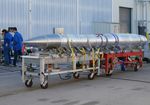SOUNDING ROCKET Quick Look - NASA
←
→
Page content transcription
If your browser does not render page correctly, please read the page content below
National Aeronautics and Space Administration
2 0 1 8 P O K E R F L AT
SOUNDING
ROCKET
CAMPAIGN
For more information, please visit our web site:
www.nasa.gov/soundingrockets
Quick Look
NP-2017-12-149-WFF www.nasa.gov2018 POKER FLAT SOUNDING ROCKET CAMPAIGN
January 15 — 31, 2018
THESE
Four launches from the Poker Flat Research SOUNDING
Range in Alaska ROCKET
CONFIGURATIONS
WILL BE
SOUNDING ROCKET FAST FACTS USED FOR
THE FOUR
LAUNCHES
Known as sounding rockets for the nautical term “to sound,” meaning to
measure, these rockets reach a region between 30 and 800 miles above
the Earth’s surface.
• The lower end of this region is otherwise inaccessible, as it’s above the maxi-
mum altitude for scientific balloons and below the minimum for satellites.
• In many instances, sounding rockets offer the only means to study certain Payload
scientific phenomena, such as the dynamics and chemistry of the upper
atmosphere.
The flight is a simple parabolic trajectory and flight time is less than 20
minutes—providing just 5 to 10 solid minutes of scientific observations
from space.
• The rocket consumes its fuel on the rising part of the flight, then separates
and falls away, leaving the payload to complete the arc and re-enter the
atmosphere. Often, it floats gently down to Earth by way of a parachute
and is then retrieved.
• By recovering parts of the payload, it can be refurbished and flown again,
resulting in tremendous savings.
Payload
Apogee
Second Stage
Separation Main
Chute
Release Second
Stage
(BLACK
BRANT)
First Stage
Separation
Second
Stage
Liftoff (IMPROVED
ORION)
Not to scale
Because sounding rockets are relatively low cost, they become perfect vehi-
cles for testing new instrument ideas while conducting cutting-edge science.
• NASA’s sounding rocket program at Wallops dates back to the agency’s
inception in 1958.
• Engineers and scientists work hand in hand at Wallops to bring innovative,
creative ideas to life with a quick turnaround time. Sounding rockets can First First
then be launched from various places around the globe—the mobile nature Stage Stage
of the program enables researchers to conduct missions from strategic (TERRIER) (TERRIER)
vantage points worldwide.
The launches from the Poker Flat Research Range in Alaska are supported
through NASA’s Sounding Rocket Program at the agency’s Wallops Flight
Facility at Wallops Island, Virginia, which is managed by NASA’s Goddard
Space Flight Center in Greenbelt, Maryland. NASA’s Heliophysics Division
manages the sounding-rocket program for the agency. Terrier-Improved Black
Orion Brant IX
www.nasa.gov/soundingrockets
Terrier-Improved Black
Orion Brant IXSOUNDING ROCKET CAMPAIGN
SOUNDING ROCKET CAMPAIGN
Super Soaker Diffuse X-Rays from
three rockets the Local Galaxy (DXL)
LAUNCH WINDOW: LAUNCH WINDOW:
January 15 – 31, 2018 January 15 – 31, 2018
LAUNCH TIME: LAUNCH TIME:
5 – 8 a.m. AKST 2 – 5 a.m. AKST
All 3 rockets launched within
a 32 minute period LAUNCH VEHICLE:
NASA Black Brant IX
LAUNCH VEHICLES: 1st stage: Terrier
NASA Terrier-Improved Orion 2nd stage: Black Brant
1st stage: Terrier
2nd stage: Improved Orion VEHICLE LENGTH:
57 feet
VEHICLE LENGTHS:
Vehicles 1 and 3: 36 feet APOGEES:
Vehicle 2: 34.5 feet 143 miles in about 4 minutes
Credit: Berit Bland
APOGEES: Credit: Berit Bland TOTAL FLIGHT TIME:
Vehicles 1 and 3: 100 miles altitude About 16 minutes Personnel at the Wallops Flight Facility test the DXL payload’s ability to
reached in about 3.3 minutes A Super Soaker payload is tested for its ability to operate connect with the Global Positioning Satellite (GPS) network which will
Vehicle 2: 61 miles altitude while experiencing vibrations during flight. be used to determine the location of the payload during flight.
PRINCIPAL INVESTIGATOR:
reached in about 2.6 minutes Massimiliano Galeazzi
University of Miami, Florida
TOTAL FLIGHT TIMES:
Vehicles 1 and 3: 7 minutes MISSION:
2018 POKER FLAT
2018 POKER FLAT
Vehicle 2: 5.5 minutes “Very low energy diffuse X-rays
from space are believed to
PRINCIPAL INVESTIGATOR: come from two sources.
Irfan Azeem The first source is located
Atmospheric & Space Technology outside our solar system and
Research Assoc. is generated by remnants of
Boulder, Colorado multiple supernovae explosions
forming what is now called the
MISSION: Local Hot Bubble region of our
“Super Soaker is a sounding rocket galaxy. The second source is
experiment designed to determine within the solar system and is
how large quantities of water generated by the solar wind
could affect the upper atmosphere charge exchange. DXL seeks to
and form Polar Mesospheric gain a better understanding of
Clouds (PMCs). Water vapor is the nature and characteristics of
a common exhaust product of these sources.”
space traffic. Super Soaker will fly – Massimiliano Galeazzi
to the upper atmosphere carrying
about 50 gallons of water, about
the amount in a bathtub. We
will release the water canister at
about 53 miles, dispersing and
vaporizing the water. We will
measure the basic state of the
upper atmosphere before, during
and after the release to determine
the impact. These measurements Credit: Berit Bland
Credit: Berit Bland
include temperature, winds and
high-altitude layers of ice particles The DXL payload is assembled at NASA’s Wallops Flight Facility in
One of the three Super Soaker payloads undergoes spin/balance Virginia prior to its shipment to the Poker Flat Research Range in Alaska.
known as PMCs.” testing in the Sounding Rocket Payload Processing Facility at
– Irfan Azeem NASA’s Wallops Flight Facility.You can also read





















































